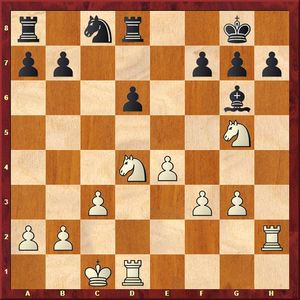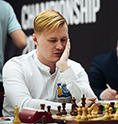18 September 2015
Taking the Bull by the Horns
Round 12 review of the Junior World Chess Championship by IM Vladimir Barsky.
The Polish grandmaster Jan-Krzysztof Duda scored a sure victory to retain the top line in the tournament table. However, the gap from his pursuers (actually, the only remaining pursuer) did not widen since the Russian Mikhail Antipov also won his game. Only these two players can claim the gold of the World Championship as the others have already fallen far behind.
Duda – Rambaldi

White just advanced his pawn to h5, attacking the enemy knight. The tension has reached its limit and Black should think hard before deciding on his next move. However, it took the Italian grandmaster no more than a couple of minutes to make up his mind.
13…Bxg5?
By and large, this move loses the game! Black could defend by 13...cxd5! 14.hxg6 (14.exd5 Bxg5 15.Nxg5 Ne7 is not dangerous for Black) 14...dxc4 15.Rxh7 Rf8 16.Bxe7 Kxe7 17.Bf1 fxg6! 18.Rxg7+ Kf6! 19.Rh7 Rh8! This line is not at all easy to calculate to the very end, but it was worth trying to do so, at the very least.
14.dxc6!
Rambaldi must have underestimated this intermediate move.
14…Qxc6
In the case of 14...Bxc6 15.Nxg5 Black loses a piece, whereas after 14...bxc6 15.Nxg5 Ne7 16.Be2 he loses a pawn.
15.Nxg5 Ne7 16.Be2 Nc8 17.Bxg4
17.Na5 Qb6 18.Bxg4 Bxg4 19.Qxg4 Qxa5 20.h6!, etc. would have been even a more precise continuation.
17...Bxg4 18.Nxe5
18.Qxg4 Qxc4 19.h6 g6 20.Qf3 would have been very strong in this position.
18...Bxd1 19.Nxc6 Bxh5 20.Nd4 Bg6 21.0–0–0 0–0 22.f3 Rd8 23.Rh2

Black miraculously managed to keep up the material balance on the board, and it was his last chance to put up an obstinate resistance: 23…Nb6! 24.Nb5 h6 25.Nh3 Nc4! However, he opted in favor of a passive defense, and Jan-Krzysztof gradually clamped Black’s position in a vice grip.
23…h6 24.Nh3 f6 25.Nf4 Bf7 26.Nf5 Kf8 27.b3 a5 28.Kb2 Ra6 29.Nd4 Rd7 30.Rhd2 Rb6 31.c4 Na7 32.c5 Ra6 33.Nf5 Nc8 34.cxd6 Rc6 35.g4 a4 36.Nh5 axb3 37.axb3 g6 38.Nxf6 Rd8 39.Nh7+ Kg8 40.Nxh6+ Kg7 41.Nxf7 Kxf7 42.Ng5+ Kf6 43.f4 Black resigns.
Yuffa – Antipov
This is yet another spectacular victory by Mikhail Antipov. The Moscow grandmaster, playing Black, chose a very aggressive opening, the Blumenfeld gambit, and then went on to offer an exchange sacrifice as well.

17…Rxa3! 18.bxa3 d3 19.Qd1
Knowing the aftermath of the game I would like to suggest that White should immediately part with a piece: 19.Qxd3!? Bxf3 20.Bxf3 Qxf3 21.Bb2. Sacrificing someone else’s material comes much easier than your own, no doubt!
19...c4
Black features a nice positional compensation in the form of his far-advanced passed pawns and the control over the central squares.
20.Ne1 Bc5 21.Bb2 0–0 22.Rc1 Qa6

23.Bxf6
Although Yuffa’s judgment about it being high time to simplify the game is obviously correct, his choice of the first piece to exchange is wrong. Correct is 23.Bxd5 exd5 (23 ... Nxd5? 24.Qg4, forking the c4- and e6-pawns would be bad for Black) 24.Bxf6 Rxf6 25.Nxd3! cxd3 26.Rc3 Qe6 27.Rxd3 with a rough equality. Although one might be convinced that after something like 27...Rh6 the Black’s threats are very dangerous, in fact they are not.
23...Bxg2 24.Nxg2 Nxf6 25.Nf4
Although White must have disliked the idea of his knight being kept out of the game after 25.a4 e5, the fate of his a-pawn should not be neglected.
25...Bxa3 26.Rb1 e5! 27.Nh5
Good advice is beyond price for White in this position. Both 27.Nxd3 and 27.Ng2 Ne4 look rather grim.
27...Ne4 28.Qg4 Qg6 29.Qd7 Nd2 30.Rb7 Qf7 31.Qxf7+ Rxf7 32.Rb8+ Rf8 33.Rb7 Nxf1 White resigns.
In the girls’ tournament the game on the first table finished quite unexpectedly. It looked like the tournament leader, the Ukrainian Nataliya Buksa, who successfully solved all her opening problems, could have continued playing the Sicilian ending with a bishop pair advantage for an indefinitely long period of time without any risk of losing. Although the key word in this phrase is, perhaps, “long”, it should be remembered that there have already passed as many as 12 days of one of the most challenging tournaments, whereas human resources are not unlimited after all. Having agreed to a draw by repetition of moves, Nataliya retained the gap against her pursuers and purchased a couple of additional leisure hours to restore herself.
Derakhshani – Buksa

Although in the case of 27...Rd8 28.Rh3 Bb7 29.Bf3 Rh8 or 28.Bf3 Bb7 29.Nd4 Bb6 White undoubtedly features a very solid position, she has to defend, nevertheless. However, the game ended in a draw by the repetition of moves.
27…Bb7 28.Nc5 Bc8 29.Nb3 Bb7 30.Nc5 Bc8 31.Nb3 Bb7 32.Nc5 Bc8 Draw.
That day saw two chess players from Kazakhstan carrying out an exactly equal number of devastating attacks.
Saduakassova – Ziaziulkina

12…f6?
The player from Belarus must have miscalculated somewhere. After 12...Qc7 or 12...Be7 Black features a solid position.
13.Bxh7! Nc4
13...fxg5 14.Qg6+ Ke7 15.Qxh5 is just very bad for Black.
14.Bg6+ Ke7 15.Bh4
15.g4! fxg5 16.Bxh5 looks very strong.
15...Qa5
More stubborn is 15...Be8, e.g.: 16.g4 Bxg6 17.Qxg6 Rh6 18.Qc2 g5!
16.0–0 Rh6 17.Rac1 Nxb2 18.Qxb2 Rxg6

19.Ne5! Rh6 20.Qxb7 Qd8 21.Nxd5+
Simple knight moves like 21.Nb5 or 21.Ne2 were winning also, but it is so difficult to resist the temptation of being able to capture something with a check!
21...exd5 22.Nxd7 Qxd7 23.Qxc8 Qxc8 24.Rxc8 g5 25.Bg3 Nxg3 26.hxg3 Black resigns.
Abdumalik – Fataliyeva

Despite White’s desire to embark on the kingside attack, the immediate 18.Ng5 runs into 18…h6, and after 19.Ne4 the knights disappear from the board. White can choose to play in a more humble manner – 18.Be3, but then 18…Bc6 with the following exemplary line: 19.Bxc5 Bxc5 20.Ng5 h5 21.Bxg6! Bxf2+! (rather than 21...fxg6 22.Qc4+, and White is winning a pawn) 22.Qxf2 fxg6 with mutual counterchances.
Zhansaya decides to take the bull by the horns.
18.b4!? Ba4?
It looks like a venturous decision to compete in better tactical vision. 18...Ne6 seems to be a reliable approach in order to meet 19.Bb3 either by the solid 19…Bd6 or by the more complex 19...e4!? 20.Qxe4 Bc6.
19.Ng5
Black must have counted on 19.Bxa4 Nxa4 20.Ng5 f5!, overtaking the initiative.
19...h6
19...f5 fails to 20.Qc4+, whereas 19...h5 is met by 20.Bxg6! fxg6 21.bxc5 Bc2 22.Qc4+.

20.Bxa4! Nxa4
A small, but important detail: 20...hxg5 is bad in view of 21.Qc4!
21.Ne4 Be7 22.Qxh6 Nxc3 23.Ng5 Bf6
In the case of 23...Bxg5 24.Bxg5 Nd5 25.Rad1 the bishop breaks through to get access to the weakened dark squares.
24.Qh7+ Kf8 25.Be3 Na4 26.Rac1 Qe7 27.Ne4 Rec8 28.Bh6+ Ke8 29.Qg8+ Kd7 30.Red1+ Black resigns.
With one round to go the top standings are as follows: Buksa – 9.5 points, Abdumalik – 9 points, Saduakassova and Alina Bivol – 8.5 points. So, both the open section and the women's tournament go on keeping up their intrigue until the very last round. The names of the world chess prince and princess will become known in a very short while!



















